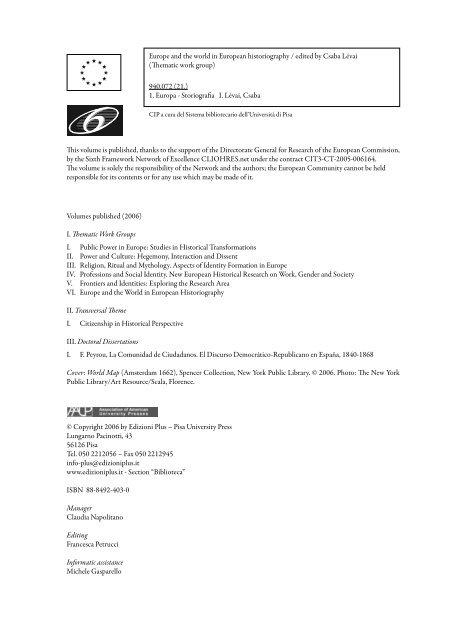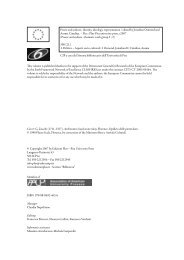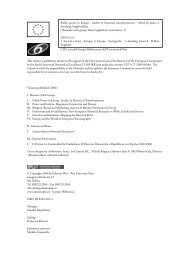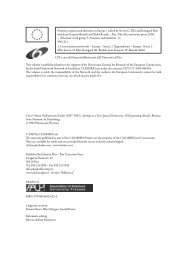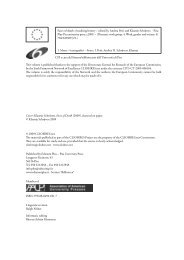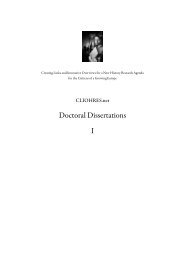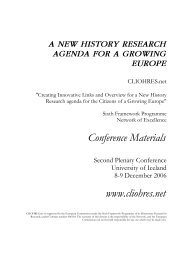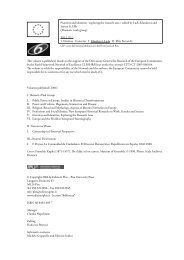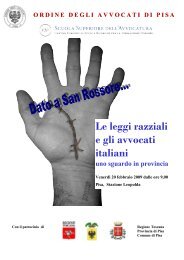Volumes published (2006) I. Thematic Work ... - CLIOHRES.net
Volumes published (2006) I. Thematic Work ... - CLIOHRES.net
Volumes published (2006) I. Thematic Work ... - CLIOHRES.net
Create successful ePaper yourself
Turn your PDF publications into a flip-book with our unique Google optimized e-Paper software.
Europe and the world in European historiography / edited by Csaba Lévai<br />
(<strong>Thematic</strong> work group)<br />
940.072 (21.)<br />
1. Europa - Storiografia I. Lévai, Csaba<br />
CIP a cura del Sistema bibliotecario dell’Università di Pisa<br />
This volume is <strong>published</strong>, thanks to the support of the Directorate General for Research of the European Commission,<br />
by the Sixth Framework Network of Excellence <strong>CLIOHRES</strong>.<strong>net</strong> under the contract CIT3-CT-2005-006164.<br />
The volume is solely the responsibility of the Network and the authors; the European Community cannot be held<br />
responsible for its contents or for any use which may be made of it.<br />
<strong>Volumes</strong> <strong>published</strong> (<strong>2006</strong>)<br />
I. <strong>Thematic</strong> <strong>Work</strong> Groups<br />
I. Public Power in Europe: Studies in Historical Transformations<br />
II. Power and Culture: Hegemony, Interaction and Dissent<br />
III. Religion, Ritual and Mythology. Aspects of Identity Formation in Europe<br />
IV. Professions and Social Identity. New European Historical Research on <strong>Work</strong>, Gender and Society<br />
V. Frontiers and Identities: Exploring the Research Area<br />
VI. Europe and the World in European Historiography<br />
II. Transversal Theme<br />
I. Citizenship in Historical Perspective<br />
III. Doctoral Dissertations<br />
I. F. Peyrou, La Comunidad de Ciudadanos. El Discurso Democrático-Republicano en España, 1840-1868<br />
Cover: World Map (Amsterdam 1662), Spencer Collection, New York Public Library. © <strong>2006</strong>. Photo: The New York<br />
Public Library/Art Resource/Scala, Florence.<br />
© Copyright <strong>2006</strong> by Edizioni Plus – Pisa University Press<br />
Lungarno Pacinotti, 43<br />
56126 Pisa<br />
Tel. 050 2212056 – Fax 050 2212945<br />
info-plus@edizioniplus.it<br />
www.edizioniplus.it - Section “Biblioteca”<br />
ISBN 88-8492-403-0<br />
Manager<br />
Claudia Napolitano<br />
Editing<br />
Francesca Petrucci<br />
Informatic assistance<br />
Michele Gasparello
Introduction<br />
This volume contains a number of short chapters about the historical connections between<br />
Europe and the World. But what is Europe, and what is the World? And what<br />
characterized the relationship between Europe and the rest of the World from the beginnings<br />
of human history to the present day? It is very difficult to answer these questions<br />
for several reasons. First of all, it is not easy to define the concepts of Europe and<br />
the World. The debates about the geographical, cultural, spiritual or political boundaries<br />
of Europe are very well known. Does Russia belong to Europe, or not? And what<br />
about Turkey? As a result of the emergence of the European Union as a new political<br />
and economic entity, the political leaders and the representatives of different professions<br />
were forced to define the boundaries and the concept of Europe. This was also<br />
true for the historical profession, the representatives of which had to realize that it is an<br />
extraordinarily difficult task. It is not easy to determine the boundaries of Europe in a<br />
given moment of time, but it is even more difficult to describe the historical changes of<br />
the concept of “Europeanness” during long periods of human history. In ancient times<br />
for example, the “civilized world” also contained territories which belonged to other<br />
continents than Europe in the geographical sense of the word. And vice versa, some regions<br />
we consider the integral part of Europe in every sense of the word belonged to the<br />
barbaricum for the inhabitants of ancient Greece or the Roman Empire. The territories<br />
of present day Syria or Tunisia were much more familiar for an educated Roman citizen<br />
than the wild forests of Germania, not to mention Scandinavia, or the territory of the<br />
present day Baltic states or Ireland. The concept of Europe as we know it, was absolutely<br />
absent, and this was also true for the medieval ages when the concept of “Christianity”<br />
substituted it.<br />
It is not the task of this introduction to formulate the final verdict about the historical<br />
definition of Europe. I would simply like to call the attention to the fact that the<br />
definition of Europe determines what is not Europe at the same time. Historically, Europe<br />
is a fluid category and, as a result, this is also true for the “world outside Europe”.<br />
The boundaries of Europe have been changing in history and there are frontier regions,<br />
which were considered the part of Europe in a given period of history, and belonged<br />
to the “world outside Europe” in another. But in one way or another, the definition of<br />
the boundaries and the concept of Europe always contain the elements of inclusion and<br />
exclusion. We might classify a country, a region, a culture, a nation or a religion as un-<br />
European because we deem it different from the concept of Europe we have in mind at<br />
a given moment of time. It means that the definition of “Europeanness” automatically<br />
determines the concept of Europeans about “otherness”. The two concepts could not<br />
exist without each other. In this sense, the historical relationship between Europe and<br />
the “world outside Europe” is the history of the constant definition of the concepts of<br />
“Europeanness” and “otherness”, but in several ways. That is, not only Europeans con-
XIV<br />
Csaba Lévai<br />
ceptualized the characteristics of “Europeanness”, but so did the representatives of the<br />
“world outside Europe”, who encountered Europeans in one way or another. For them,<br />
Europeans represented “the others”, and when they struggled with the characterization<br />
of “Europeanness”, they invented the definition of “otherness” in reference to themselves.<br />
When Europeans and the representatives of the “world outside Europe” encountered<br />
each other both parties started to formulate the concepts of “otherness”, and it<br />
was not easy for either of them to decipher the formulations of their counterpart.<br />
The case of Cabeza de Vaca (c. 1490-1557), the 16th century Spanish soldier is a good<br />
example. De Vaca was the treasurer and the second-in-command of the expedition of<br />
Panfilo de Narváez (c. 1478-1528) to discover and conquer Florida and the lands beyond<br />
in 1528. But the fierce resistance of the Apalachee Indians of Northern Florida<br />
forced the conquistadors to retreat to the coast where the Spanish constructed five<br />
barges to coast around the Gulf of Mexico. They were shipwrecked on the coast of<br />
present day Texas, and most of the conquerors soon died of disease, exposure, and malnutrition.<br />
The surviving few became the slaves of the Karankawa Indians. This was the<br />
total reversal of the original roles, and interestingly enough eventually the four surviving<br />
conquistadors became the magical healers of the natives, who assumed that only<br />
they possessed the power to cure the deadly new illnesses associated with the arrival of<br />
the Spaniards. One band of Indians passed the healers on to the next group, and in this<br />
way they moved westward across Texas and New Mexico into northwestern Mexico,<br />
where they were “liberated” by Spanish slavers. As a result of his experiences among the<br />
Indians de Vaca internalized many of the values of the natives and started to view his<br />
former role as conquistador from a different angle. He saw his “liberators” with the eyes<br />
of the natives when he noted in one of his writings that “We healed the sick, they killed<br />
the sound; we came naked and barefoot, they clothed, horsed, and lanced; we coveted<br />
nothing but gave whatever we were given, while they robbed whomever they found”. As<br />
Alan Taylor noted, in the narrative of de Vaca “the they described his own past as well as<br />
the immediate slavers, for in them he saw what he had been eight years before in Florida<br />
with a sword in hand, destroying Apalachee villages” 1 .<br />
But only a few Europeans went through the same experiences and most of the Europeans<br />
encountering “the others” did not realize the other side of the coin. In most cases, mutual<br />
understanding of the perception of “otherness” proved to be very difficult between Europeans<br />
and the representatives of the “world outside Europe” for most of the five centuries<br />
after the “great explorations”. The sixth thematic workgroup of <strong>CLIOHRES</strong>.<strong>net</strong><br />
project is dedicated to the study of the historical connections between Europe and the<br />
rest of the World, and one of the fundamental aims of this co-operation is the promotion<br />
of mutual understanding of “otherness” among Europeans and the representatives<br />
of the “world outside Europe”, through the study of history. Fifteen eminent staff members<br />
and eleven doctoral students represent ten European and one African university in<br />
the thematic workgroup. We have members from northwestern (University of Iceland,<br />
Ghent University, National University of Ireland, Galway, University of Sussex), southern<br />
(University of Deusto, Bilbao, University of Valencia, Portuguese Open University,
Introduction XV<br />
Lisbon), and eastern Europe (University of Debrecen, University of Maribor, Moscow<br />
State Regional University), while Africa is represented by the University of KwaZulu<br />
Natal (Durban, South Africa). The staff members and the doctoral students have very<br />
different backgrounds and fields of interest. But it is a common characteristic of all of<br />
them that, in one way or another, they are dedicated to the research and understanding<br />
of the extremely complex historical relationship of Europe and the “world outside Europe”.<br />
<strong>CLIOHRES</strong>.<strong>net</strong> is a five-year project and we hope that by the end of this period<br />
our group will develop a sophisticated and well-organized co-operation dedicated to the<br />
research of certain aspects of the historical relations of Europe and the rest of the World.<br />
We are still at the beginning of this process, but we have made the first steps towards the<br />
above-mentioned goal. We have finished the first year of the project, the fundamental<br />
task of which was the mapping and exploration of current definitions, problems and approaches<br />
regarding “Europe and the World” in national historiographies. This volume<br />
is the result of this “mapping and exploration”.<br />
Very different countries with very different historical and historiographical traditions<br />
are represented in this thematic workgroup. One can find real great powers in it with<br />
long-standing imperial and maritime traditions (Great Britain, Spain, Russia), smaller<br />
countries, which once were the cores of their own imperial structures (Portugal, Belgium),<br />
Atlantic and African countries, which were the parts of larger empires for significant<br />
periods of their history (Iceland, Ireland, South Africa), and East Central European<br />
regions, which belonged to European continental empires for centuries (Hungary,<br />
Slovenia). Due to their different geographical positions and historical past the intensity<br />
and the characteristics of their relationship with the “world outside Europe” was also<br />
very different. The Vikings departing from Iceland were playing a leading role in the<br />
early European discovery of Greenland and North America in the 10th century. Spain,<br />
Great Britain and Russia were the cores of large empires including extensive non-European<br />
territories. Portugal and Belgium were much smaller countries, but they could<br />
establish their own extensive empires outside Europe. Ireland and South Africa became<br />
part of the British Empire and as a result both of them had intense relations with the<br />
“world outside Europe” on the one hand, and with the Old Continent on the other. In<br />
the case of these countries the relevance of the study of the historical contacts between<br />
Europe and the “world outside Europe” is clear and well established from the point of<br />
view of their historiography. But this is not unequivocal in the case of such countries as<br />
Hungary and Slovenia, the geographical position of which prevented them from playing<br />
any significant role in the expansion of Europe after the 15th century. But this does<br />
not mean at the same time that the history of the relationship of Europe and the rest of<br />
the world is totally irrelevant for the historians of these countries. For centuries, both of<br />
them constituted parts of the Habsburg Empire which was one of the major players in<br />
European great power politics. In the 16th and 17th centuries the Habsburgs also ruled<br />
the Spanish Empire and as a result, the conflicts of the European maritime empires such<br />
as Britain, France or Spain also inevitably affected the Eastern or Danubian Habsburg<br />
Empire, including the historical Hungarian Kingdom and the regions inhabited by the
XVI<br />
Csaba Lévai<br />
Slovenes. And in some periods of their history more direct connections were also established<br />
between Eastern Europe and the “world outside Europe”. The peoples of this<br />
European region constituted the most important element among the immigrants to the<br />
United States of America between 1903 and 1913, for example. All the nations of the<br />
Austro-Hungarian Monarchy took part in the migratory phenomenon, including the<br />
Hungarians and the Slovenes.<br />
The chapters of this volume mirror the differences of these distinct traditions of historiography.<br />
All contributions discuss the historiography of a special topic relating to<br />
the history of Europe and the “world outside Europe”. Since the interests of the staff<br />
members and the doctoral students contributing to this volume are very different, we<br />
decided to arrange the chapters according to the continents involved in the historical<br />
relations with Europe which they study. The first part contains three chapters, which<br />
were not classifiable in this way, since they relate to the historical relationship of Europe<br />
with more than one continent, or in a more general manner. Anna Agnarsdóttir (staff<br />
member, University of Iceland) provides a summary of Iceland’s interesting and not<br />
very well known relations with the “world outside Europe”, which in the case of this relatively<br />
isolated island practically meant everything outside itself. Matjaz Klemenčič and<br />
Danijel Grafenauer (staff member and doctoral student, University of Maribor) show<br />
us how the history of the world outside Europe has been taught in a small East Central<br />
European country with relatively weak traditions in this field. Victor N. Zakharov (staff<br />
member, Moscow State Regional University) discusses the development of historiography<br />
on Western European merchants in Russia in the 18th century, a very relevant<br />
topic from the point of view of Europe and the world, since this was the period of the<br />
emergence of Russia as a multi-continental empire. And the last chapter of part one<br />
was composed by Emilio Saenz-Francés San Baldomero (doctoral student, University<br />
of Deusto Bilbao) who explores the complicated foreign relations of Spain towards the<br />
world outside Europe during World War II on the basis of some new documentation.<br />
Part two contains three studies on the historical contacts between Europe and Africa.<br />
Two Belgian scholars struggle with the inheritance of their country’s colonial past. Guy<br />
Vanthemsche summarizes the different trends of Belgian historiography regarding the<br />
country’s colonizing activities in Congo, while Geert Castryck (doctoral student, Ghent<br />
University) focuses on the “home front” and studies the manifestations of the colonial<br />
past in Belgium’s public sphere. The author of the third study about Africa is Donal<br />
McCracken (staff member, University Kwa-Zulu Natal), who discusses the complex<br />
interdependence of South Africa’s African and European historical inheritance in the<br />
historiographical tradition of the country.<br />
Part three is about the relationship of Europe and Asia and contains four studies. Attila<br />
Bárány (staff member, University of Debrecen) calls the attention of the historical<br />
profession to the not very well-known role that Hungary and some Hungarian kings<br />
played in the history of Crusades. Vinita Damodaran (University of Sussex) explores<br />
how the British perceived and constructed at the same time the different races and<br />
tribes in India during the 19th century. Ana Paula Avelar (staff member, Aberta Uni-
Introduction XVII<br />
versity) reveals how the newly explored Asian territories were depicted and interpreted<br />
in 16th century Portuguese historiography. And in the last study of part three Gábor<br />
Demeter (doctoral student, University of Debrecen) summarizes the debates about<br />
domestic and foreign politics in the Ottoman Empire at the beginning of the 20th<br />
century from a historiographical point of view.<br />
The concluding section is about the relationship of Europe and the American continent<br />
and comprised four studies, two about Europe and Latin America, and two about Europe<br />
and North America. In respect of Latin America, Mary N. Harris (Staff member<br />
National University of Ireland, Galway) surveys the perception of Irish-Latin American<br />
contacts in Irish historiography, while Maria Alexandra Gago da Câmara (staff member,<br />
Aberta University) explores the mutual impact of baroque art in Portugal and Brazil.<br />
Regarding the historical contacts of Europe and North America István Kornél Vida<br />
(doctoral student, University of Debrecen) provides an overview of the historiography<br />
of Hungarian emigration to the United States of America after the Hungarian Revolution<br />
and War for Independence in 1848-1849, and Csaba Lévai (staff member, University<br />
of Debrecen) summarizes the evaluation of the American Revolution in Hungarian<br />
historiography during the decades after World War II.<br />
Due to the very different special fields of the members of our workgroup this volume<br />
provides only a first approach to the extremely complex historical interdependence of<br />
Europe and the “world outside Europe” and the ways that historiography in different<br />
contexts has approached the issue. Nevertheless, we hope that our volume genuinely<br />
represents some recent trends of historiography concerning the relationship of Europe<br />
and the rest of the world, and serves the fundamental aim of our workgroup: the promotion<br />
of the mutual understanding of “otherness” from a historical perspective.<br />
Csaba Lévai<br />
University of Debrecen<br />
Note<br />
1<br />
Cabeza De Vaca is quoted by A. Taylor, American Colonies, New York 2001, p. 70.


